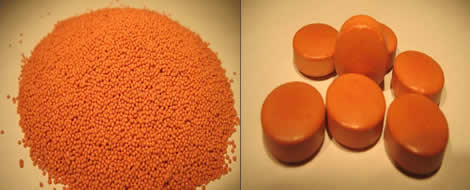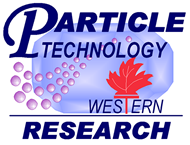
Pharmaceutical solid dosage forms include tablets, pellets, pills, beads, spherules and so on are often coated for various reasons, such as odour/taste masking, protection from moisture, prevention from destruction by gastric acid or gastric enzymes, enhanced mechanical strength, aesthetics and controlled release. Currently, the most common technology for coating solid dosage forms is the liquid coating technology. In liquid coating, a mixture of polymers, pigments and excipients is dissolved in an organic solvent (for water insoluble polymers) or water (for water soluble polymers) to form a solution, or dispersed in water to form a dispersion, and then sprayed onto the dosage forms in a pan coater (for tablets) and dried by continuously providing heat, typically using hot air, until a dry coating film is formed. However, vaporizing the liquid is extremely energy consumptive. Air cleaning is also a huge burden to the process, as the hot air has to be cleaned at both intake and outlet. Small dosages such as pellets and particles are currently coated in fluidized beds which requires even larger amount of hot air. Using organic solvents further results in environmental pollution, solvent recycling cost and operation dangers of explosion.
Our research team has developed a new ultrafine powder coating technology for the automobile and other industries and has several patents for its. This technology has now been successfully adapted for coating tablets and beads at the laboratory scale, showing a great potential for a new processes. In dry powder coating, no solvent or water solution is used, and the coating is carried-out in a pan coater by spraying dry-powders on the surface of the dosages directly. After curing, a compact and uniform layer of film is formed.
This new dry powder coating process (patent-pending) has many advantages over the aqueous coating: much lower energy requirements, efficient utilization of coating materials, environmentally friendliness, and lower operating costs. The same coating pan used in aqueous coating systems can be used for this new dry powder coatings process with only minor modifications. In term of energy saving, this new process uses only about 5% of the hot air currently used and saves about 70-80% in energy. It also eliminates the huge air cleaning system, which is normally 70% of the capital cost for tablet coating machines. A patent has been filed on this technology and a tentative licensed agreement has been signed with a Toronto-based pharmaceutical company to co-develop this technology towards commercialization. Selected licenses in certain parts of the world are still available.
Dry powder coating can be applied in coating of pharmaceutical solid dosage (such as pellets, particles, tablets, capsule and so on), food (such as candy and so on) and any other solid forms that need coating.
Technological targets:
The films prepared by this dry powder coating are as compact and shiny as those prepared by the aqueous coating method. The thickness of the coating is adjustable (tablets: 2.0~4.0%; particles: 10~40%); the total operation time is less than 1 hour; and the pressing air requirement is 0.67~3.0 m 3 /Kg solid dosage.
Two items, dry powder coating application equipment and the coating pan, are involved in the achievements of this dry powder coating technology. Due to the fact that there is no solvent involved in this coating formulation, problems such as: time and energy required for the coating process as a result of solvent evaporation; investment in equipments for dealing with the wasted air; and pollution of the environment are overcome. The dry powder coating pan is similar to that used in aqueous coating technology. The aqueous coating pan can be applied in the dry coating technology with a little modification. And the dry powder-coating pan is suitable for the coating of solid dosages with any particle size. Most importantly it replaces the fluidized bed that is used for the coating of small particle solid dosage through aqueous coating technology (with above problems), and then decreases the investment of equipment, space occupied and dealing with wasted air.
The benefits of this achievement are: lower energy cost, shorter operation time, removal of the requirement for dealing with wasted air. Furthermore, the decrease in space occupied by dry powder coating equipment will provide added economical benefits. Overall, dry powder coating is a new technology and equipment with great market prospects. It will lead to great social, economic and environmental benefits propelling pharmaceutical coatings into a new era.
Also from this web page:

Contact Info
Particle Technology Research Centre (PTRC)
Faculty of Engineering
University of Western Ontario
London, ON, Canada, N6A 5B8
Tel: (519) 661-4243
Fax: (519) 661-3498
Email: powder@uwo.ca


